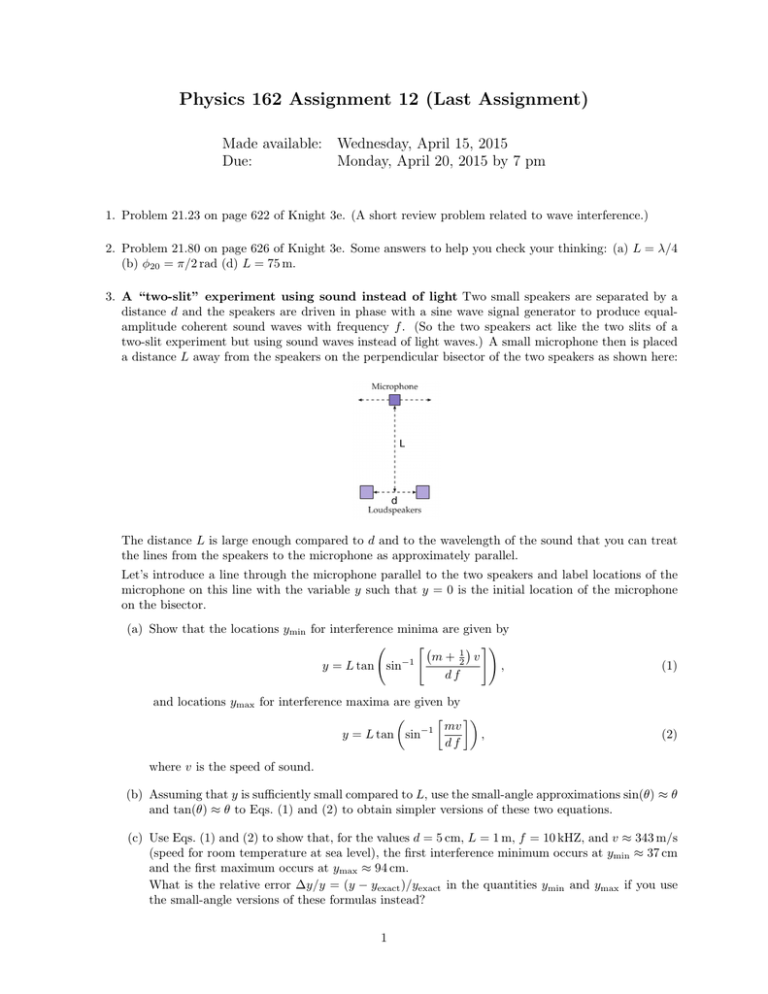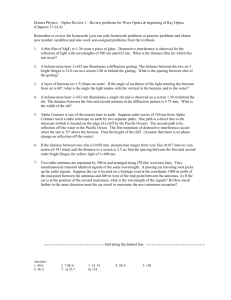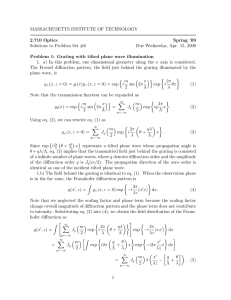Physics 162 Assignment 12 (Last Assignment) Made available: Wednesday, April 15, 2015 Due:
advertisement

Physics 162 Assignment 12 (Last Assignment) Made available: Wednesday, April 15, 2015 Due: Monday, April 20, 2015 by 7 pm 1. Problem 21.23 on page 622 of Knight 3e. (A short review problem related to wave interference.) 2. Problem 21.80 on page 626 of Knight 3e. Some answers to help you check your thinking: (a) L = λ/4 (b) ϕ20 = π/2 rad (d) L = 75 m. 3. A “two-slit” experiment using sound instead of light Two small speakers are separated by a distance d and the speakers are driven in phase with a sine wave signal generator to produce equalamplitude coherent sound waves with frequency f . (So the two speakers act like the two slits of a two-slit experiment but using sound waves instead of light waves.) A small microphone then is placed a distance L away from the speakers on the perpendicular bisector of the two speakers as shown here: The distance L is large enough compared to d and to the wavelength of the sound that you can treat the lines from the speakers to the microphone as approximately parallel. Let’s introduce a line through the microphone parallel to the two speakers and label locations of the microphone on this line with the variable y such that y = 0 is the initial location of the microphone on the bisector. (a) Show that the locations ymin for interference minima are given by ( [( ) ]) m + 12 v −1 y = L tan sin , df and locations ymax for interference maxima are given by ( [ ]) −1 mv y = L tan sin , df (1) (2) where v is the speed of sound. (b) Assuming that y is sufficiently small compared to L, use the small-angle approximations sin(θ) ≈ θ and tan(θ) ≈ θ to Eqs. (1) and (2) to obtain simpler versions of these two equations. (c) Use Eqs. (1) and (2) to show that, for the values d = 5 cm, L = 1 m, f = 10 kHZ, and v ≈ 343 m/s (speed for room temperature at sea level), the first interference minimum occurs at ymin ≈ 37 cm and the first maximum occurs at ymax ≈ 94 cm. What is the relative error ∆y/y = (y − yexact )/yexact in the quantities ymin and ymax if you use the small-angle versions of these formulas instead? 1 4. Problem 22.20 on page 649 of Knight 3e. You should get the answer ∆θ ≈ 3◦ to one digit but you should give your answer to two significant digits. 5. Problem 22.73 on page 653 of Knight 3e. 6. The standards for a high definition television (HDTV) require that, independent of screen size, the screen be rectangular with width to height in the ratio 16 : 9 ≈ 1.78 and that the corresponding resolution be 1920 pixels × 1080 pixels. The size of an HDTV screen is then typically summarized by a single length d, which is taken to be the length of the screen’s diagonal. Based on the Rayleigh criterion for resolving two points whose images are blurred by diffaction, derive a mathematical expression for the approximate closest distance L(d) that people can sit from an HDTV with a given screen size d without being able to resolve the individual pixels, so that viewers will see a nice smooth unpixelated image. (Assume that all lengths in your formula are measured in units of meters). Your formula can then be used to choose the largest possible HDTV for a room with a given depth L. What does your formula predict for the closest distance to sit for a TV with d = 46 in, which is a popular intermediate-size HDTV. Note that your equation needs to take into account explicitly that the pixels can display a range of colors spanning the visual spectrum, and that the pupils of adult human eyes vary from 3-8 mm depending on the ambient lighting in the room. 7. You have learned that if you have N identical synchronized (in phase or coherent) wave sources each of the form u(r, t) = u0 cos(kr − ωt) = u0 cos(2π(r/λ − t/T )) with waves of wavelength λ and period T , and if the sources are equally spaced along a line with spatial separation d, then the effect of all the sources at a remote point P can be written in the following mathematical form utotal (P, t) = u0 cos (kr1 − ωt) + u0 cos (kr2 − ωt) + . . . [ ( )] = Re u0 ei(kr1 −ωt) 1 + z + z 2 + . . . + z N −1 , [ ] i(kr1 −ωt) i(N −1)k∆r/2 sin [(N/2)k∆r] = Re u0 e e , sin [(1/2)k∆r] z = eik∆r = eid sin(θ) , (3) where (r1 , θ) is the location in polar coordinates from the first source to the point P and where ∆r = ri+1 − ri ≈ d sin(θ) is the constant extra distance from point P one source is from its neighbor. This expression can be used to analyze the light transmitted through a diffraction grating or, by Huygens principle, the diffraction of light passing from a narrow slit. Starting from these observations, derive a mathematical expression for the total wave utotal (P, t) at some remote point P that lies in the plane of a rectangular 3 × 4 grid of 12 identical synchronous transmitters consisting of three columns of four transmitters each, in which transmitters in a column are all separated by the same distance d and transmitters in a row are separated by a distance w. You can assume that the point of interest P is so far away that all lines from the transmitters to P are approximately parallel. Your goal specifically is to identify how Eq. (3) gets modified by the presence of extra columns of identical transmitters. Hint: Each column will yield an expression similar to Eq. (3) but with a different distance r1 . Think about how r1 changes as you go from the top of one column to the top of an adjacent column. Then see if you can pull everything together to get a concise expression for the effect of the entire grid of transmitters, in terms of a ratio of sine functions. Note: one problem where a grid of transmitters might arise in the future is to use the light pressure from many powerful lasers firing in phase to accelerate a light sail to the nearest star. A related reciprocal problem is to use a grid of radio telescopes to increase the overall sensitivity and resolution. 2 8. A diffraction grating is made out of a thin opaque sheet by cutting N ≥ 2 narrow equally spaced parallel slits with spacing d such that the width of each slit is half the width of the slit on its left. A source of coherent monochromatic light with wavelength λ is placed on one side of the grating such that the light intensity is uniform over the grating. The resulting diffraction pattern is then observed on a planar screen that is parallel to and a large distance L away from the diffraction grating. A location on the screen can be described in the usual way via an angle θ that is measured from the line segment perpendicular to the grating and screen that connects the centers of the grating and screen. A top-down view of the grating, screen, and angle θ looks like this for the case N = 3 (not drawn to scale): (a) Show that the light intensity I(θ) on the screen is given by ( ( )) 1 + 4−N − 21−N cos N kd sin(θ) 2 ( ) I(θ) = u0 , 5/4 − cos kd sin(θ) (4) where u20 is the light intensity coming out of the largest slit. Some hints: the amplitude of a wave coming out of a slit is proportional to the width of the slit. So if the light coming out of the widest slit has the form u0 cos(kr − ωt) with amplitude u0 , then the light coming out of the adjacent slit that is half as wide will have the mathematical form (u0 /2) cos(kx − ωt), and so on for the smaller slits. Use complex amplitudes to calculate the sum (superposition) of all the waves coming out of the slits at some point P at position θ on the screen and use somewhere the fact that the screen is far away from all the slits. You will obtain an expression of the form Re[Z(θ, r, t)] in which case the light intensity is given by I(θ) = |Z|2 . A final comment is that you will not be able to use the factoring trick Z N − 1 = Z N/2 − Z −N/2 that we used for the uniform diffraction grating (do you understand why), so you will have to calculate the magnitude |Z| directly using your skills with complex numbers. (b) Explain why Eq. (4) implies that no dark fringes will be observed on the screen. Note: a dark fringe means the light intensity I becomes zero, so you need to explain why the numerator of the right side of Eq. (4 is always nonzero. A further hint is to think about the magnitude of the factor 21−N as N becomes large, and also keep in mind that the cosine function has a magnitude less than or equal to one. (c) In the limit of many slits (N → ∞), show that Eq. (4) simplifies mathematically and use your simplified expression to draw qualitatively the light intensity curve I(θ) for this non-uniform grating. Hint: In your simplified expression, for what angles do local minima and maxima occur and what are the values of I(θ) at these extrema? 9. Time to Complete This Assignment To one significant digit, please give the time in hours that it took you to complete this homework assignment. 3 10. Optional Challenge Problems (a) Challenge problem 12.1: A beam of monochromatic light impinges on a transmission diffraction grating at normal incidence. Describe qualitatively and quantitatively how the interference pattern on a viewing screen changes if the grating is rotated through an angle ϕ < π/2 about an axis that is perpendicular to the lines of the grating. (b) Challenge problem 12.2: You are likely familiar with the fact that a person who breathes in some helium gas (say from a party balloon ) and then tries to speak in a normal voice will have a highpitched voice. Imagine putting an entire symphony orchestra with string instruments, woodwinds, brass instruments (like trumpets), and percussion instruments (drums, triangle) in a helium gas environment. Which instruments, if any, will sound normal? Which will have a higher pitch? Do any instruments have a lower pitch? (c) Challenge problem 12.3: Consider three identical square planar mirrors that are glued together to form three adjacent sides of a cube meeting at a corner, with the mirrored sides all facing towards each other. Show that these mirrors act as a universal reflector that sends light back to its source: any light beam entering this arrangement of mirrors will leave parallel and opposite to its original direction. Note: such corner reflectors were left on the surface of the Moon by American astronauts so that scientists could bounce laser pulses from the Earth off the Moon and back to Earth. This enabled precise measurements of the distance of the Moon to the Earth (by recording the return time of a laser pulse), and led to the ability to detect earthquakes (ok, really moonquakes) on the Moon from Earth. 4






